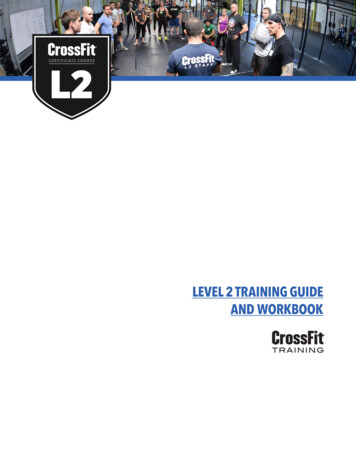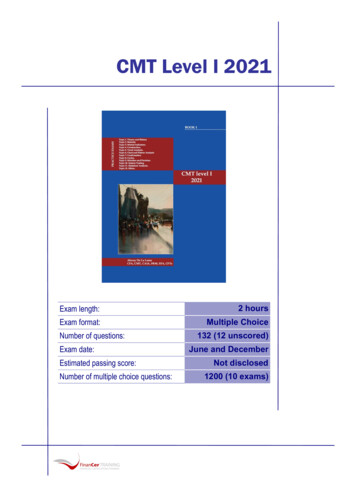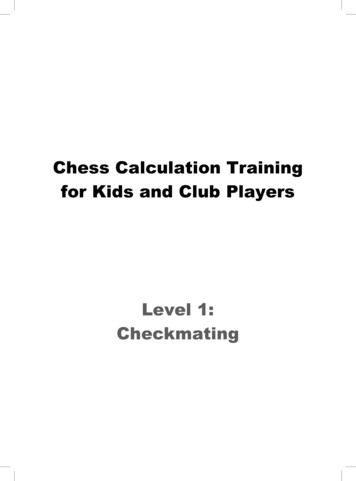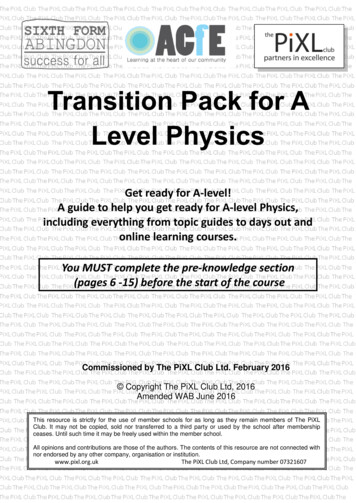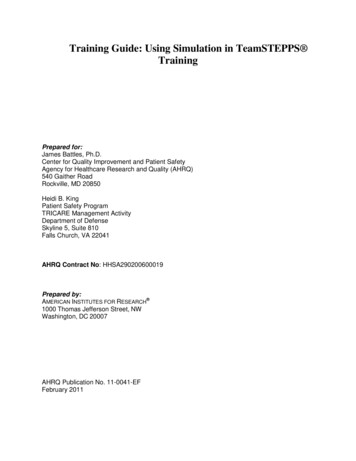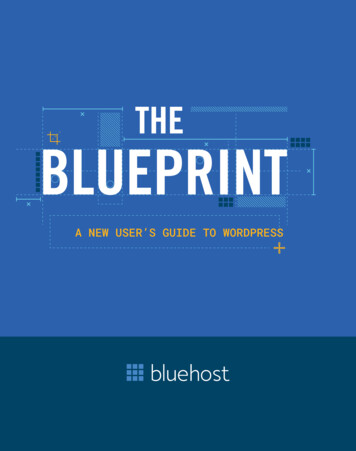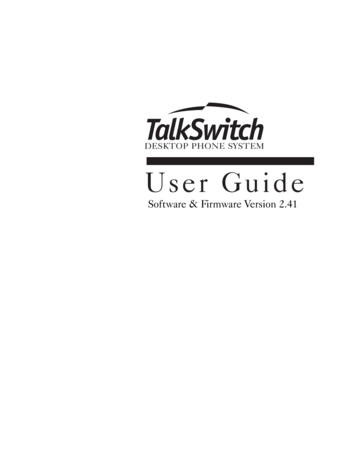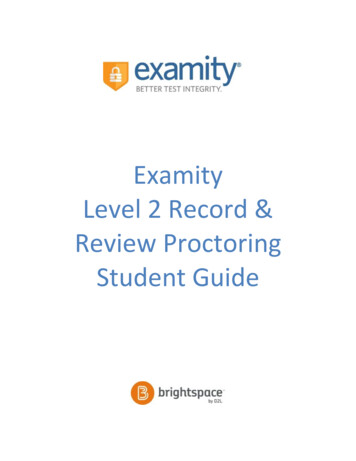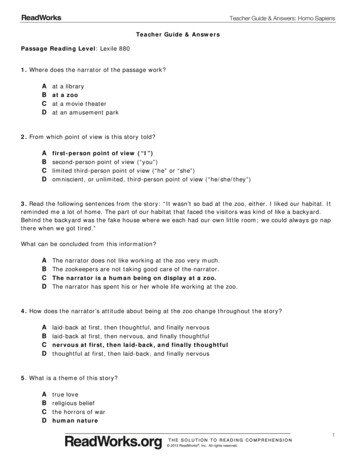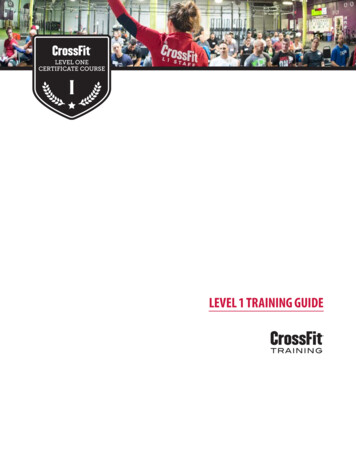
Transcription
LEVEL 1 TRAINING GUIDE
Level 1 Training Guide CrossFitThe CrossFit Level 1 Training Guide is a collection of CrossFit Journal articleswritten since 2002 primarily by CrossFit, Inc. Founder Coach Greg Glassman onthe foundational movements and methodology of CrossFit, Inc.This guide is designed to be used in conjunction with the Level 1 Course to developthe participant’s knowledge and trainer skills and as an essential resource foranyone who is interested in improving their own health and fitness.Some edits to the original articles have been made for the Training Guide to flowas a stand-alone reference, to provide context for readers, and to stay current withthe course format. All original works are preserved in the CrossFit Journal. 2002–2019 CrossFit, Inc.All rights reserved. No part of this publication may be reproduced in any mannerwithout permission. All images are copyrighted by the artists and reproduced withthe kind permission of the artists and/or their representatives.Every effort has been made to contact copyright holders and to ensure that all theinformation presented is correct. Some of the facts in this volume may be subjectto debate or dispute. If proper copyright acknowledgment has not been made, orfor clarifications and corrections, please contact the publishers and we will correctthe information in future reprintings, if any.No seminar other than the CrossFit Level 1 Certificate Course, as run by CrossFit,grants you the title CrossFit Trainer. Official events can only be verified by usingCrossFit.com for registration or by emailing seminars@crossfit.com with your inquiry.Official qualifications for any individual can be verified in CrossFit’s Trainer Directory.Only CrossFit, Inc. offers the CrossFit Level 1 Certificate Course, and the coursehas no prerequisites. Only successful completion of this course allows a trainer toapply for affiliation with CrossFit. If an affiliate or other fitness organization claimsotherwise, it should be reported to iptheft.crossfit.com.Second EditionLCCN: 2017941775
TABLE OF CONTENTSLevel 1 Training Guide CrossFitMethodologyUnderstanding CrossFit. . . . . . . . . . . . . . . . . . . . . . . . . . 2Foundations. . . . . . . . . . . . . . . . . . . . . . . . . . . . . . . . . . . . . . 5What Is Fitness? (Part 1) . . . . . . . . . . . . . . . . . . . . . . . . 17What Is Fitness? (Part 2) . . . . . . . . . . . . . . . . . . . . . . . . 32Technique. . . . . . . . . . . . . . . . . . . . . . . . . . . . . . . . . . . . . . 40Nutrition: Avoiding Disease andOptimizing Performance. . . . . . . . . . . . . . . . . . . . . . . 45Fitness, Luck and Health . . . . . . . . . . . . . . . . . . . . . . . 50Zone Meal Plans. . . . . . . . . . . . . . . . . . . . . . . . . . . . . . . . 53Typical CrossFit Block Prescriptionsand Adjustments. . . . . . . . . . . . . . . . . . . . . . . . . . . . . . . 65Supplementation. . . . . . . . . . . . . . . . . . . . . . . . . . . . . . . . . . . 68A Theoretical Template for CrossFit’sProgramming. . . . . . . . . . . . . . . . . . . . . . . . . . . . . . . . . . . . . . . 71Scaling CrossFit. . . . . . . . . . . . . . . . . . . . . . . . . . . . . . . . . . . . . 77“The Girls” for Grandmas. . . . . . . . . . . . . . . . . . . . . . . . . . 83Running a CrossFit Class. . . . . . . . . . . . . . . . . . . . . . . . . . . 87Lesson Plan: Fran . . . . . . . . . . . . . . . . . . . . . . . . . . . . . . 88Lesson Plan: Back Squat . . . . . . . . . . . . . . . . . . . . . . 92Lesson Plan: 20-Minute AMRAP. . . . . . . . . . . . . . 96MovementsAnatomy and Physiology for Jocks . . . . . . . . . . . . . 100Squat Clinic. . . . . . . . . . . . . . . . . . . . . . . . . . . . . . . . . . . . . . . . . 104The Overhead Squat. . . . . . . . . . . . . . . . . . . . . . . . . . . . . . 111Shoulder Press, Push Press, Push Jerk . . . . . . . . . . 118The Deadlift. . . . . . . . . . . . . . . . . . . . . . . . . . . . . . . . . . . . . . . . 123Medicine-Ball Cleans. . . . . . . . . . . . . . . . . . . . . . . . . . . . . . 127The Glute-Ham Developer (GHD). . . . . . . . . . . . . . . 131Trainer GuidanceWhere Do I Go From Here?. . . . . . . . . . . . . . . . . . . . . . . 142Responsible Training. . . . . . . . . . . . . . . . . . . . . . . . . . . . . . . 151Fundamentals, Virtuosity and Mastery:An Open Letter to CrossFit Trainers. . . . . . . . . . . . . 158Professional Training. . . . . . . . . . . . . . . . . . . . . . . . . . . . . . 160Scaling Professional Training . . . . . . . . . . . . . . . . . . . . 162CrossFit Level 1 Trainer Certificate LicenseAgreement in Plain English . . . . . . . . . . . . . . . . . . . . . . 166Frequently Asked Questions. . . . . . . . . . . . . . . . . . . . . 167CrossFit Credentials. . . . . . . . . . . . . . . . . . . . . . . . . . . . . . . 169Movement GuideNine Foundational Movements Summary. . . . . 170The Air Squat . . . . . . . . . . . . . . . . . . . . . . . . . . . . . . . . . . 171The Front Squat . . . . . . . . . . . . . . . . . . . . . . . . . . . . . . . 176The Overhead Squat. . . . . . . . . . . . . . . . . . . . . . . . . . 178The Shoulder Press . . . . . . . . . . . . . . . . . . . . . . . . . . . 180The Push Press. . . . . . . . . . . . . . . . . . . . . . . . . . . . . . . . . 184The Push Jerk. . . . . . . . . . . . . . . . . . . . . . . . . . . . . . . . . . 188The Deadlift. . . . . . . . . . . . . . . . . . . . . . . . . . . . . . . . . . . . 194The Sumo Deadlift High Pull . . . . . . . . . . . . . . . . 201The Medicine-Ball Clean . . . . . . . . . . . . . . . . . . . . . 208Four Additional Movements Summary. . . . . . . . . 218The Pull-up. . . . . . . . . . . . . . . . . . . . . . . . . . . . . . . . . . . . . 219The Thruster. . . . . . . . . . . . . . . . . . . . . . . . . . . . . . . . . . . 227The Muscle-up. . . . . . . . . . . . . . . . . . . . . . . . . . . . . . . . . 232The Snatch. . . . . . . . . . . . . . . . . . . . . . . . . . . . . . . . . . . . . 240IndexIndex . . . . . . . . . . . . . . . . . . . . . . . . . . . . . . . . . . . . . . . . . . . . . . . . 248Alphabetical Listing of Figures . . . . . . . . . . . . . . . . . . 255Alphabetical Listing of Tables. . . . . . . . . . . . . . . . . . . 2551 of 255Copyright 2019 CrossFit Inc. All Rights ReservedDV5.3.1-20190416KW
METHODOLOGYLevel 1 Training Guide CrossFitUnderstanding CrossFit, continuedUnderstanding CrossFitOriginally published in April 2007.The aims, prescription, methodology, implementation, and adaptations of CrossFitare collectively and individually unique, defining of CrossFit, and instrumental inour program’s successes in diverse applications.AimsFrom the beginning, the aim of CrossFit has been to forge a broad, general, andinclusive fitness. We sought to build a program that would best prepare traineesfor any physical contingency–prepare them not only for the unknown but forthe unknowable. Looking at all sport and physical tasks collectively, we askedwhat physical skills and adaptations would most universally lend themselvesto performance advantage. Capacity culled from the intersection of all sportsdemands would quite logically lend itself well to all sport. In sum, our specialty isnot specializing.PrescriptionCrossFit is: “constantly varied, high-intensity functional movement.” This is ourprescription. Functional movements are universal motor recruitment patterns;they are performed in a wave of contraction from core to extremity; and they arecompound movements–i.e., they are multi-joint. They are natural, effective, andefficient locomotors of body and external objects. But no aspect of functionalmovements is more important than their capacity to move large loads over longdistances, and to do so quickly. Collectively, these three attributes (load, distance,and speed) uniquely qualify functional movements for the production of highpower. Intensity is defined exactly as power, and intensity is the independentvariable most commonly associated with maximizing the rate of return of favorableadaptation to exercise. Recognizing that the breadth and depth of a program’sstimulus will determine the breadth and depth of the adaptation it elicits, ourprescription of functionality and intensity is constantly varied. We believe that22 ofof 255Copyright 2019 CrossFit Inc. All Rights Reserved
METHODOLOGYLevel 1 Training Guide CrossFitUnderstanding CrossFit, continuedpreparation for random physical challenges–i.e., unknown and unknowableevents–is at odds with fixed, predictable, and routine regimens.MethodologyThe methodology that drives CrossFit is entirely empirical. We believe thatmeaningful statements about safety, efficacy, and efficiency, the three mostimportant and interdependent facets to evaluate any fitness program, canbe supported only by measurable, observable, repeatable data. We call thisapproach “evidence-based fitness.” CrossFit’s methodology depends on fulldisclosure of methods, results, and criticisms, and we have employed the internetto support these values. Our charter is open source, making co-developers out ofparticipating coaches, athletes, and trainers through a spontaneous and collaborative online community. CrossFit is empirically driven, clinically tested, andcommunity developed.ImplementationIn implementation, CrossFit is, quite simply, a sport—the Sport of Fitness. We havelearned that harnessing the natural camaraderie, competition, and fun of sport orgame yields an intensity that cannot be matched by other means. The late Col.Jeff Cooper observed that “the fear of sporting failure is worse than the fear ofdeath.” It is our observation that men will die for points. Using whiteboards asscoreboards, keeping accurate scores and records, running a clock, and preciselydefining the rules and standards for performance, we not only motivate unprecedented output but derive both relative and absolute metrics at every workout;this data has important value well beyond motivation.“We’ve taken highintensity, constantlyvaried functionalworkouts and distilledload, range of motion,exercise, power,work, line of action,flexibility, speed,and all pertinentmetabolics to asingle value–usuallytime. This is the Sportof Fitness. We’rebest at it.”—COACH GLASSMANAdaptationsOur commitment to evidence-based fitness, publicly posting performance data,co-developing our program in collaboration with other coaches, and our opensource charter in general have well positioned us to garner important lessons fromour program–to learn precisely and accurately, that is, about the adaptations elicitedby CrossFit programming. What we have discovered is that CrossFit increases workcapacity across broad time and modal domains (see “What Is Fitness? (Part 2)”article). This is a discovery of great import and has come to motivate our programming and refocus our efforts. This far-reaching increase in work capacity supportsour initially stated aims of building a broad, general, and inclusive fitness program.It also explains the wide variety of sport demands met by CrossFit, as evidencedby our deep penetration among diverse sports and endeavors. We have come tosee increased work capacity as the Holy Grail of performance improvement andall other common metrics like VO2 max, lactate threshold, body composition, andeven strength and flexibility as being correlates–derivatives, even. We would nottrade improvements in any other fitness metric for a decrease in work capacity.3 of 255Copyright 2019 CrossFit Inc. All Rights Reserved
METHODOLOGYLevel 1 Training Guide CrossFitUnderstanding CrossFit, continuedConclusionsThe modest start of publicly posting our daily workouts on the internet beginningin 2001 has evolved into a community where human performance is measuredand publicly recorded against multiple, diverse, and fixed workloads. CrossFit is anopen-source engine where inputs from any quarter can be publicly given to demonstrate fitness and fitness programming, and where coaches, trainers, and athletescan collectively advance the art and science of optimizing human performance.4 of 255Copyright 2019 CrossFit Inc. All Rights Reserved
METHODOLOGYLevel 1 Training Guide CrossFitFoundations, continuedFoundationsOriginally published in April 2002.CrossFit is a core strength and conditioning program. We have designed ourprogram to elicit as broad an adaptational response as possible. CrossFit is nota specialized fitness program but a deliberate attempt to optimize physicalcompetence in each of 10 fitness domains. They are cardiovascular/respiratoryendurance, stamina, strength, flexibility, power, speed, coordination, agility,balance, and accuracy.CrossFit was developed to enhance an individual’s competency at all physicaltasks. Our athletes are trained to perform successfully at multiple, diverse, andrandomized physical challenges. This fitness is demanded of military and policepersonnel, firefighters, and many sports requiring total or complete physicalprowess. CrossFit has proven effective in these arenas.5 of 255Copyright 2019 CrossFit Inc. All Rights Reserved
METHODOLOGYLevel 1 Training Guide CrossFitFoundations, continuedAside from the breadth or totality of fitness CrossFit seeks, our program isdistinctive, if not unique, in its focus on maximizing neuroendocrine response,developing power, cross-training with multiple training modalities, constanttraining and practice with functional movements, and the development ofsuccessful diet strategies.Our athletes are trained to bike, run, swim, and row at short, middle, and longdistances, guaranteeing exposure and competency in each of the three mainmetabolic pathways.We train our athletes in gymnastics from rudimentary to advanced movements,garnering great capacity at controlling the body both dynamically and staticallywhile maximizing strength-to-weight ratio and flexibility. We also place a heavyemphasis on Olympic weightlifting, having seen this sport’s unique ability todevelop an athlete’s explos
The CrossFit Level 1 Training Guide is a collection of CrossFit Journal articles written since 2002 primarily by CrossFit, Inc. Founder Coach Greg Glassman on the foundational movements and methodology of CrossFit, Inc. This guide is designed to be used in


